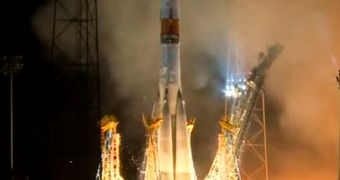The European Space Agency's (ESA) Gaia space telescope has successfully lifted off from South America at 0912 GMT (10:12 CET) today, December 19. The observatory will spend the next 5 years studying the positions and motions of more than 1 billion stars in the Milky Way and beyond.
You can replay the 1h20min full transmission of the event at this link.
Gaia will produce the most accurate and detailed 3D map of our galaxy ever attempted, by analyzing around 1 percent of the total number of stars it contains. Current estimates place the total number of stars in the Milky Way at around 100 billion.
By figuring out how so many stellar objects move, astronomers will be able to gain a deeper insight into how our galaxy emerged, developed and grew to its current size. Recent studies put the total diameter of our galaxy at around 100,000 light-years.
Gaia was taken into orbit by a Russian-built Soyuz medium-lift delivery system featuring a Fregat upper stage. The rocket took off from a dedicated launch facility at the ESA Kourou Spaceport, in French Guiana, South America.
Mission controllers reported that the Fregat stage separated from the delivery system around 10 minutes after launch, and added that the firing was successful in injecting the telescope into its designated parking low-Earth orbit, at an altitude of 175 kilometers (108 miles).
About 11 minutes later, a new Fregat ignition sequence took Gaia to its transfer orbit, where the telescope separated from the upper stage some 42 minutes later. Mission trackers at the ESA European Space Operations Center (ESOC), in Darmstadt, Germany, established contact with the spacecraft shortly afterwards.
ESA announced that Gaia was able to deploy its massive sunshield between the 78- and 88-minute marks. The observatory is currently on its way to the L2 Lagrangian point, some 1.5 million kilometers (932,000 miles) away from Earth.
Mission controllers estimate that it will take 2 engine firings to get the telescope into position. The first one will occur tomorrow, December 20, while the second one is scheduled to take place in about 20 days. After L2 is reached, Gaia will spend the next 4 months commissioning its delicate instruments.
“Gaia promises to build on the legacy of ESA’s first star-mapping mission, Hipparcos, launched in 1989, to reveal the history of the galaxy in which we live,” said the Director General of ESA, Jean-Jacques Dordain.
“It is down to the expertise of Europe’s space industry and scientific community that this next-generation mission is now well and truly on its way to making ground-breaking discoveries about our Milky Way,” he added after the launch.
Gaia is scheduled to spend a minimum of 5 years in space, during which time it will analyze the individual position and motion of 1 billion stars around 70 times each. The tiny differences in position will be used to create a complex 3D map of the Milky Way.
“Gaia represents a dream of astronomers throughout history, right back to the pioneering observations of the ancient Greek astronomer Hipparchus, who cataloged the relative positions of around a thousand stars with only naked-eye observations and simple geometry,” concluded the ESA Director of Science and Robotic Exploration, Alvaro Giménez.

 14 DAY TRIAL //
14 DAY TRIAL //